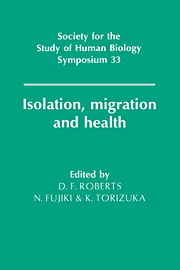Book contents
- Frontmatter
- Contents
- List of contributors
- Preface
- 1 The legacy of the IBP: Presidential Address
- 2 The distinction between primary and secondary isolates
- 3 Time trends in the break-up of isolates
- 4 Factors influencing the frequency of consanguineous marriages in Japan
- 5 Break-up of isolates
- 6 Isolates in India: their origin and characterisation
- 7 Consanguineous marriages and their genetical consequences in some Indian populations
- 8 Biomedical and immunogenetic variation in isolated populations in India
- 9 Genetic distance analyses in Israeli groups using classical markers and DNA polymorphisms in the β globin gene
- 10 Non-random distribution of Gm haplotypes in northern Siberia
- 11 Allele frequency estimation
- 12 Genetic affinities of human populations
- 13 Inherited neurological diseases in island isolates in southern Japan
- 14 Serological and virological evidence for human T-lymphotropic virus type I infection among the isolated Hagahai of Papua New Guinea
- 15 Analysis of genes associated with hypercholesterolaemia in the Japanese population
- 16 Migrant studies and their problems
- 17 Tokelau: migration and health in a small Polynesian society - a longitudinal study
- 18 Micromigrations of isolated Tuareg tribes of the Sahara Desert
- 19 Population structure in the eastern Adriatic: the influence of historical processes, migration patterns, isolation and ecological pressures, and their interaction
- 20 Diabetes and diabetic macroangiopathy in Japanese-Americans
- 21 Diabetes and westernisation in Japanese migrants
- 22 Environmental factors affecting ischemic heart disease
- Epilogue
- Index
Preface
Published online by Cambridge University Press: 05 March 2012
- Frontmatter
- Contents
- List of contributors
- Preface
- 1 The legacy of the IBP: Presidential Address
- 2 The distinction between primary and secondary isolates
- 3 Time trends in the break-up of isolates
- 4 Factors influencing the frequency of consanguineous marriages in Japan
- 5 Break-up of isolates
- 6 Isolates in India: their origin and characterisation
- 7 Consanguineous marriages and their genetical consequences in some Indian populations
- 8 Biomedical and immunogenetic variation in isolated populations in India
- 9 Genetic distance analyses in Israeli groups using classical markers and DNA polymorphisms in the β globin gene
- 10 Non-random distribution of Gm haplotypes in northern Siberia
- 11 Allele frequency estimation
- 12 Genetic affinities of human populations
- 13 Inherited neurological diseases in island isolates in southern Japan
- 14 Serological and virological evidence for human T-lymphotropic virus type I infection among the isolated Hagahai of Papua New Guinea
- 15 Analysis of genes associated with hypercholesterolaemia in the Japanese population
- 16 Migrant studies and their problems
- 17 Tokelau: migration and health in a small Polynesian society - a longitudinal study
- 18 Micromigrations of isolated Tuareg tribes of the Sahara Desert
- 19 Population structure in the eastern Adriatic: the influence of historical processes, migration patterns, isolation and ecological pressures, and their interaction
- 20 Diabetes and diabetic macroangiopathy in Japanese-Americans
- 21 Diabetes and westernisation in Japanese migrants
- 22 Environmental factors affecting ischemic heart disease
- Epilogue
- Index
Summary
The symposium, held at Phoenix Plaza, Fukui, Japan, July 30-31 1990, to celebrate the 20th anniversary of the International Association of Human Biologists was highly successful. The theme was isolation and migration, for the reasons given in his presidential address by Professor Fujiki. Participants were invited to present their work on the dynamics of these two processes, and their implications for biology and health. The contributions are reproduced in this volume.
The symposium owed its success to many factors. It was the first IAHB conference to be held in the Orient. It was itself part of a week-long joint conference with the Japanese Society of Human Genetics (celebrating its 35th anniversary), preceded by a satellite discussion organised by the Council for International Organisations of Medical Sciences. The proceedings of other discussions during the week on ‘Genetics, ethics and human values’ and on ‘Education and bioethics in medical genetics’ have been published under the title ‘;Medical genetics and society’ (1990) edited by N. Fujiki, V. Bulyzhenkov and Z. Bankowski. But much of its success stemmed from the especially cordial relations between the organising committees and the Fukui Medical School, whose members contributed with immense energy and enthusiasm to the week's events. We are glad to record publicly our indebtedness to Fukui Medical School, to all members of the committees responsible for organising the meetings, and particularly to Professor Emeritus E. Matsunaga, former Director of the National Institute of Genetics.
- Type
- Chapter
- Information
- Isolation, Migration and Health , pp. xi - xiiPublisher: Cambridge University PressPrint publication year: 1992

